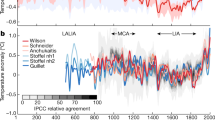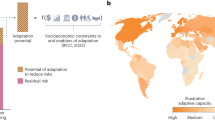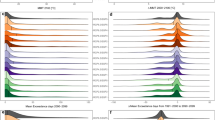Abstract
In seeking to understand how future societies will be affected by climate change we cannot simply assume they will be identical to those of today, because climate and societies are both dynamic. Here we propose that the concept of demographic metabolism and the associated methods of multi-dimensional population projections provide an effective analytical toolbox to forecast important aspects of societal change that affect adaptive capacity. We present an example of how the changing educational composition of future populations can influence societies' adaptive capacity. Multi-dimensional population projections form the human core of the Shared Socioeconomic Pathways scenarios, and knowledge and analytical tools from demography have great value in assessing the likely implications of climate change on future human well-being.
This is a preview of subscription content, access via your institution
Access options
Access Nature and 54 other Nature Portfolio journals
Get Nature+, our best-value online-access subscription
$29.99 / 30 days
cancel any time
Subscribe to this journal
Receive 12 print issues and online access
$209.00 per year
only $17.42 per issue
Buy this article
- Purchase on Springer Link
- Instant access to full article PDF
Prices may be subject to local taxes which are calculated during checkout



Similar content being viewed by others
Change history
02 March 2017
Owing to technical problems, this Perspective was published online later than the date given in the print version. The published date should read '2 March 2017', and is correct in the online versions.
References
Hazeleger, W. et al. Tales of future weather. Nat. Clim. Change 5, 107–113 (2015).
Jakob, C. Going back to basics. Nat. Clim. Change 4, 1042–1045 (2014).
Collins, M. et al. Quantifying future climate change. Nat. Clim. Change 2, 403–409 (2012).
IPCC Climate Change 2014: Impacts, Adaptation, and Vulnerability (eds Field, C. B. et al.) (Cambridge University Press, 2014).
Tanser, F. C., Sharp, B. & le Sueur, D. Potential effect of climate change on malaria transmission in Africa. Lancet 362, 1792–1798 (2003).
White, G. F., Kates, R. W. & Burton, I. Knowing better and losing even more: the use of knowledge in hazards management. Glob. Environ. Change Part B Environ. Hazards 3, 81–92 (2001).
van Bergeijk, P. A. G. & Lazzaroni, S. Macroeconomics of natural disasters: strengths and weaknesses of meta-analysis versus review of literature. Risk Anal. 35, 1050–1072 (2015).
Ehrlich, P. R. & Holdren, J. P. Impact of population growth. Science 171, 1212–1217 (1971).
Kaya, Y. IPCC Energy and Industry Subgroup (Response Strategies Working Group, 1990).
O'Neill, B. C., MacKellar, F. L. & Lutz, W. Population and Climate Change (Cambridge Univ. Press, 2001).
Pearson, C. S. On the Cusp: From Population Boom to Bust (Oxford Univ. Press, 2015).
Gemenne, F. Why the numbers don't add up: a review of estimates and predictions of people displaced by environmental changes. Glob. Environ. Change 21 (suppl. 1), S41–S49 (2011).
Migration and Global Environmental Change: Future Challenges and Opportunities (The Government Office for Science, 2011).
McLeman, R. A. & Hunter, L. M. Migration in the context of vulnerability and adaptation to climate change: insights from analogues. Wiley Interdiscip. Rev. Clim. Change 1, 450–461 (2010).
Lutz, W. & Striessnig, E. Demographic aspects of climate change mitigation and adaptation. Popul. Stud. 69, S69–S76 (2015).
Coleman, J. S. Social capital in the creation of human capital. Am. J. Sociol. 94, S95–S120 (1988).
Lipset, S. M. Some social requisites of democracy: economic development and political legitimacy. Am. Polit. Sci. Rev. 53, 69–105 (1959).
Milligan, K., Moretti, E. & Oreopoulos, P. Does education improve citizenship? Evidence from the United States and the United Kingdom. J. Public Econ. 88, 1667–1695 (2004).
Lutz, W., Crespo Cuaresma, J. & Abbasi-Shavazi, M. J. Demography, education, and democracy: global trends and the case of Iran. Popul. Dev. Rev. 36, 253–281 (2010).
Lutz, W. & KC, S. Global human capital: integrating education and population. Science 333, 587–592 (2011).
Lutz, W. Demographic metabolism: a predictive theory of socioeconomic change. Popul. Dev. Rev. 38, 283–301 (2013).
Mannheim, K. Essays on the Sociology of Knowledge (ed. Kecskemeti, P.) 276–332 (Routledge & Kegan Paul, 1952).
Ryder, N. B. The cohort as a concept in the study of social change. Am. Sociol. Rev. 30, 843–861 (1965).
Ryder, N. B. The Cohort Approach: Essays in the Measurement of Temporal Variations in Demographic Behavior (Ayer Publishing, 1980).
Land, K. C. & Rogers, A. Multidimensional Mathematical Demography (Academic Press, 1982).
Keyfitz, N. Applied Mathematical Demography (Springer Verlag, 1985).
Lutz, W., Crespo Cuaresma, J. & Sanderson, W. C. The demography of educational attainment and economic growth. Science 319, 1047–1048 (2008).
Inglehart, R. Public support for environmental protection: Objective problems and subjective values in 43 societies. PS Polit. Sci. Polit. 28, 57–72 (1995).
Brooks, C. & Bolzendahl, C. The transformation of US gender role attitudes: cohort replacement, social-structural change, and ideological learning. Soc. Sci. Res. 33, 106–133 (2004).
Pampel, F. Cohort change, diffusion, and support for gender egalitarianism in cross-national perspective. Demogr. Res. 25, 667–694 (2011).
Andersen, R. & Fetner, T. Cohort differences in tolerance of homosexuality attitudinal change in Canada and the United States, 1981–2000. Public Opin. Q. 72, 311–330 (2008).
Lutz, W., Kritzinger, S. & Skirbekk, V. The demography of growing European identity. Science 314, 425–425 (2006).
Striessnig, E. & Lutz, W. Demographic strengthening of European identity. Popul. Dev. Rev. 42, 305–311 (2016).
Weber, D., Skirbekk, V., Freund, I. & Herlitz, A. The changing face of cognitive gender differences in Europe. Proc. Natl. Acad. Sci. USA 111, 11673–11678 (2014).
Bordone, V., Scherbov, S. & Steiber, N. Smarter every day: the deceleration of population ageing in terms of cognition. Intelligence 52, 90–96 (2015).
Cooper, R., Hardy, R., Sayer, A. A. & Kuh, D. in A Life Course Approach to Healthy Ageing (eds. Kuh, D., Cooper, R., Hardy, R. & Richards, M.) 16–31 (Oxford Univ. Press, 2013).
Watts, N. et al. Health and climate change: policy responses to protect public health. Lancet Lond. Engl. 386, 1861–1914 (2015).
Adger, W. N. et al. in Climate Change 2007: Impacts, Adaptation and Vulnerability. (eds. Parry, M. L. et al.) 717–743 (IPCC, Cambridge Univ. Press, 2007).
Grossman, M. in Handbook of the Economics of Education Vol. 1 (eds Hanushek, E. A. & Welch, F.) 577–633 (Elsevier, 2006).
Brunello, G., Fort, M., Schneeweis, N. & Winter-Ebmer, R. The causal effect of education on health: what is the role of health behaviors? Health Econ. 25, 314–336 (2015).
Gathmann, C., Jürges, H. & Reinhold, S. Compulsory schooling reforms, education and mortality in twentieth century Europe. Soc. Sci. Med. 127, 74–82 (2015).
Conti, G., Heckman, J. & Urzua, S. The education-health gradient. Am. Econ. Rev. 100, 234–238 (2010).
Blair, C., Gamson, D., Thorne, S. & Baker, D. Rising mean IQ: cognitive demand of mathematics education for young children, population exposure to formal schooling, and the neurobiology of the prefrontal cortex. Intelligence 33, 93–106 (2005).
Baker, D. P., Salinas, D. & Eslinger, P. J. An envisioned bridge: schooling as a neurocognitive developmental institution. Dev. Cogn. Neurosci. 2 (suppl. 1), S6–S17 (2012).
Brinch, C. N. & Galloway, T. A. Schooling in adolescence raises IQ scores. Proc. Natl. Acad. Sci. USA 109, 425–430 (2012).
Lewis, C. M., Baldassarre, A., Committeri, G., Romani, G. L. & Corbetta, M. Learning sculpts the spontaneous activity of the resting human brain. Proc. Natl Acad. Sci. USA 106, 17558–17563 (2009).
Welberg, L. Neuroimaging: learning changes the resting brain. Nat. Rev. Neurosci. 10, 766–767 (2009).
Bruine de Bruin, W., Parker, A. M. & Fischhoff, B. Individual differences in adult decision-making competence. J. Pers. Soc. Psychol. 92, 938–956 (2007).
Peters, E. et al. Numeracy and decision making. Psychol. Sci. 17, 407–413 (2006).
Cutler, D. M. & Lleras-Muney, A. Understanding differences in health behaviors by education. J. Health Econ. 29, 1–28 (2010).
Kenkel, D. S. Health behavior, health knowledge, and schooling. J. Polit. Econ. 99, 287–287 (1991).
van der Pol, M. Health, education and time preference. Health Econ. 20, 917–929 (2011).
Huang, J., van den Brink, H. & Groot, W. A meta-analysis of the effect of education on social capital. Econ. Educ. Rev. 28, 454–464 (2009).
Lake, R. L. D. & Huckfeldt, R. Social capital, social networks, and political participation. Polit. Psychol. 19, 567–584 (1998).
Kahn, M. E. The death toll from natural disasters: the role of income, geography, and institutions. Rev. Econ. Stat. 87, 271–284 (2005).
Kellenberg, D. K. & Mobarak, A. M. Does rising income increase or decrease damage risk from natural disasters? J. Urban Econ. 63, 788–802 (2008).
Sadowski, N. C. & Sutter, D. Hurricane fatalities and hurricane damages: are safer hurricanes more damaging? South. Econ. J. 72, 422–432 (2005).
Crespo Cuaresma, J., Lutz, W. & Sanderson, W. C. Is the demographic dividend an education dividend? Demography 51, 299–315 (2013).
Lutz, W. Sola schola et sanitate: human capital as the root cause and priority for international development? Philos. Trans. R. Soc. B 364, 3031–3047 (2009).
Lutz, W., Muttarak, R. & Striessnig, E. Universal education is key to enhanced climate adaptation. Science 346, 1061–1062 (2014).
Patt, A. G. et al. Estimating least-developed countries' vulnerability to climate-related extreme events over the next 50 years. Proc. Natl Acad. Sci. USA 107, 1333–1337 (2010).
Striessnig, E., Lutz, W. & Patt, A. G. Effects of educational attainment on climate risk vulnerability. Ecol. Soc. 18 (1), 16 (2013).
Pamuk, E. R., Fuchs, R. & Lutz, W. Comparing relative effects of education and economic resources on infant mortality in developing countries. Popul. Dev. Rev. 37, 637–664 (2011).
Fuchs, R., Pamuk, E. & Lutz, W. Education or wealth: which matters more for reducing child mortality in developing countries? Vienna Yearbook Popul. Res. 8, 175–199 (2010).
KC, S. Community vulnerability to floods and landslides in Nepal. Ecol. Soc. 18(1), 8 (2013).
Muttarak, R. & Pothisiri, W. The role of education on disaster preparedness: case study of 2012 Indian Ocean earthquakes on Thailand's Andaman coast. Ecol. Soc. 18 (4), 51 (2013).
Sharma, U., Patwardhan, A. & Patt, A. G. Education as a determinant of response to cyclone warnings: evidence from coastal zones in India. Ecol. Soc. 18 (2), 18 (2013).
Wamsler, C., Brink, E. & Rantala, O. Climate change, adaptation, and formal education: the role of schooling for increasing societies' adaptive capacities in El Salvador and Brazil. Ecol. Soc. 17 (2), 2 (2012).
Muttarak, R. & Lutz, W. Is education a key to reducing vulnerability to natural disasters and hence unavoidable climate change? Ecol. Soc. 19 (1), 42 (2014).
Hoffmann, R. & Muttarak, R. Learn from the past, prepare for the future: Impacts of education and experience on disaster preparedness in the Philippines and Thailand. World Dev. http://dx.doi.org/10.1016/j.worlddev.2017.02.016 (in the press).
Frankenberg, E., Sikoki, B., Sumantri, C., Suriastini, W. & Thomas, D. Education, vulnerability, and resilience after a natural disaster. Ecol. Soc. 18 (2), 16 (2013).
Guha-Sapir, D., Parry, L. V., Degomme, O., Joshi, P. C. & Saulina Arnold, J. P. Risk Factors for Mortality and Injury: Post-tsunami Epidemiological Findings from Tamil Nadu (Centre for Research of the Epidemiology of Disasters, 2006).
Padli, J. & Habibullah, M. S. Natural disaster death and socio-economic factors in selected Asian countries: a panel data analysis. Asian Soc. Sci. 5, 65–71 (2009).
Epstein, R. S., Fullerton, C. S. & Ursano, R. J. Posttraumatic stress disorder following an air disaster: a prospective study. Am. J. Psychiatry 155, 934–938 (1998).
Norris, F. H. et al. 60,000 disaster victims speak: Part I. An empirical review of the empirical literature, 1981–2001 Psychiatry 65, 207–239 (2002).
Tang, B., Liu, X., Liu, Y., Xue, C. & Zhang, L. A meta-analysis of risk factors for depression in adults and children after natural disasters. BMC Public Health 14, 623 (2014).
Noy, I. The macroeconomic consequences of disasters. J. Dev. Econ. 88, 221–231 (2009).
Toya, H. & Skidmore, M. Economic development and the impacts of natural disasters. Econ. Lett. 94, 20–25 (2007).
Garbero, A. & Muttarak, R. Impacts of the 2010 droughts and floods on community welfare in rural Thailand: differential effects of village educational attainment. Ecol. Soc. 18 (4), 27 (2013).
Patnaik, U., Das, P. K. & Bahinipati, C. S. Coping with climatic shocks: empirical evidence from rural coastal Odisha, India. Glob. Bus. Rev. 17, 161–175 (2016).
Thomas, T., Christiaensen, L., Do, Q. T. & Trung, L. D. Natural Disasters and Household Welfare: Evidence from Vietnam (World Bank, 2010).
Gitter, S. R. & Barham, B. L. Credit, natural disasters, coffee, and educational attainment in rural Honduras. World Dev. 35, 498–511 (2007).
Helgeson, J. F., Dietz, S. & Hochrainer-Stigler, S. Vulnerability to weather disasters: the choice of coping strategies in rural Uganda. Ecol. Soc. 18 (2), 2 (2013).
Lee, T. M., Markowitz, E. M., Howe, P. D., Ko, C.-Y. & Leiserowitz, A. A. Predictors of public climate change awareness and risk perception around the world. Nat. Clim. Change 5, 1014–1020 (2015).
Deressa, T. T., Hassan, R. M., Ringler, C., Alemu, T. & Yesuf, M. Determinants of farmers' choice of adaptation methods to climate change in the Nile Basin of Ethiopia. Glob. Environ. Change 19, 248–255 (2009).
Mugi-Ngenga, E. W. et al. Household's socio-economic factors influencing the level of adaptation to climate variability in the dry zones of Eastern Kenya. J. Rural Stud. 43, 49–60 (2016).
Paul, C. J., Weinthal, E. S., Bellemare, M. F. & Jeuland, M. A. Social capital, trust, and adaptation to climate change: evidence from rural Ethiopia. Glob. Environ. Change 36, 124–138 (2016).
Van Aelst, K. & Holvoet, N. Intersections of gender and marital status in accessing climate change adaptation: evidence from rural Tanzania. World Dev. 79, 40–50 (2016).
Drabo, A. & Mbaye, L. M. Natural disasters, migration and education: an empirical analysis in developing countries. Environ. Dev. Econ. 20, 767–796 (2015).
IPCC Special Report on Emissions Scenarios (eds Nakicenovic, N. & Swart, R.) (Cambridge Univ. Press, 2000).
KC, S. & Lutz, W. The human core of the shared socioeconomic pathways: population scenarios by age, sex and level of education for all countries to 2100. Glob. Environ. Change 42, 181–192 (2014).
Leimbach, M., Kriegler, E., Roming, N. & Schwanitz, J. Future growth patterns of world regions — A GDP scenario approach. Glob. Environ. Change 42, 215–225 (2015).
Jiang, L. & O'Neill, B. C. Global urbanization projections for the Shared Socioeconomic Pathways. Glob. Environ. Change 42, 193–199 (2015).
KC, S. & Lutz, W. Demographic scenarios by age, sex and education corresponding to the SSP narratives. Popul. Environ. 35, 243–260 (2014).
Lutz, W., Butz, W. P. & KC, S. World Population and Human Capital in the 21st Century. (Oxford Univ. Press, 2014).
Fankhauser, S. The costs of adaptation. Wiley Interdiscip. Rev. Clim. Change 1, 23–30 (2010).
Klein, R. J. T. et al. Technological options for adaptation to climate change in coastal zones. J. Coast. Res. 17, 531–543 (2001).
Sovacool, B. K. Hard and soft paths for climate change adaptation. Clim. Policy 11, 1177–1183 (2011).
Rojas, R., Feyen, L. & Watkiss, P. Climate change and river floods in the European Union: socio-economic consequences and the costs and benefits of adaptation. Glob. Environ. Change 23, 1737–1751 (2013).
Klein, R. J. T. in Climate: Global Change and Local Adaptation (eds Linkov, I. & Bridges, T. S.) 157–168 (Springer, 2011).
Hallegatte, S., Green, C., Nicholls, R. J. & Corfee-Morlot, J. Future flood losses in major coastal cities. Nat. Clim. Change 3, 802–806 (2013).
Economics of Adaptation to Climate Change — Synthesis Report (World Bank, 2010).
Robine, J.-M. et al. Death toll exceeded 70,000 in Europe during the summer of 2003. C. R. Biol. 331, 171–178 (2008).
Doocy, S., Gorokhovich, Y., Burnham, G., Balk, D. & Robinson, C. Tsunami mortality estimates and vulnerability mapping in Aceh, Indonesia. Am. J. Public Health 97, S146–S151 (2007).
Doocy, S., Daniels, A., Murray, S. & Kirsch, T. D. The human impact of floods: a historical review of events 1980–2009 and systematic literature review. PLoS Curr. http://doi.org/bxwk (2013).
Zagheni, E., Muttarak, R. & Striessnig, E. Differential mortality patterns from hydro-meteorological disasters: evidence from cause-of-death data by age and sex. Vienna Yearbook Popul. Res. 13, 47–70 (2015).
Acknowledgements
Partial support for this work was provided by the European Research Council (ERC) Advanced Investigator Grant entitled 'Forecasting Societies' Adaptive Capacities to Climate Change' (ERC-2008-AdG 230195-FutureSoc). We would like to thank Samir KC and Nadia Steiber for their comments and input in the preparation of the manuscript.
Author information
Authors and Affiliations
Contributions
W.L. and R.M. contributed equally in the conception of the work, drafting and revising the manuscript. Author names are listed alphabetically.
Corresponding author
Ethics declarations
Competing interests
The authors declare no competing financial interests.
Rights and permissions
About this article
Cite this article
Lutz, W., Muttarak, R. Forecasting societies' adaptive capacities through a demographic metabolism model. Nature Clim Change 7, 177–184 (2017). https://doi.org/10.1038/nclimate3222
Received:
Accepted:
Published:
Issue Date:
DOI: https://doi.org/10.1038/nclimate3222
This article is cited by
-
Risk transfer policies and climate-induced immobility among smallholder farmers
Nature Climate Change (2021)
-
Population dynamics and natural hazard risk management: conceptual and practical linkages for the case of Austrian policy making
Natural Hazards (2021)
-
Scales and sensitivities in climate vulnerability, displacement, and health
Population and Environment (2021)
-
Erratum: Forecasting societies' adaptive capacities through a demographic metabolism model
Nature Climate Change (2017)



